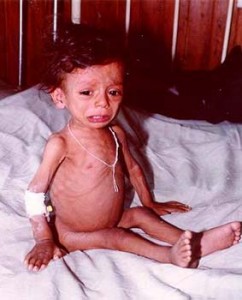Water is the single largest component of the human body, accounting for most of its weight. We lose water through sweat, tears, saliva, urine, stool, and even a little with breathing. We replenish it with food and drink. A dehydrated child has too little fluid. She may be taking too little in (by refusing to drink or eat) or putting too much out (with vomiting or diarrhea) or both. How do you know when your child is getting dehydrated? The answer is that everything gets dry: your child will not make as much urine as usual, and when the does urinate, it will look darker than normal; she will have fewer tears; the inside of her mouth might be dry; and her tongue will be rough like sandpaper. The most common cause of dehydration in toddlers is stomach flu. The medical term for this condition is gastroenteritis. A child with gastroenteritis loses fluid when she vomits and has diarrhea. There can be trouble replenishing this fluid because of her refusal to drink or inability to keep liquids down. It is rela¬tively easy to get dehydrated this way.
Other causes of vomiting or diarrhea can also lead to dehydration. These include intestinal obstruction (from a hernia, for example), food allergy, infection, and bowel inflammation (for instance, celiac disease). With any of these, fluid loss can outpace replenishment, and your child can become dehydrated.
 Sometimes dehydration results only from refusal to drink. Remember that the body loses water throughout the day, so without drinking, the body’s water surplus is not maintained. Infec¬tion of the mouth or throat is the most common reason for a toddler to refuse to drink. Viruses (such as Coxsackie virus, which causes handfoot-mouth disease) and bacteria (such as Group A beta-hemolytic streptococcus, which causes strep throat) can cause so much pain that toddlers will refuse liquids.
Sometimes dehydration results only from refusal to drink. Remember that the body loses water throughout the day, so without drinking, the body’s water surplus is not maintained. Infec¬tion of the mouth or throat is the most common reason for a toddler to refuse to drink. Viruses (such as Coxsackie virus, which causes handfoot-mouth disease) and bacteria (such as Group A beta-hemolytic streptococcus, which causes strep throat) can cause so much pain that toddlers will refuse liquids.
In the most severe cases, a child won’t even swallow her own saliva.
Dehydration is classified as mild, moderate, or severe. Because water is such a large component of body weight, water loss causes weight loss. Therefore, weight loss can be used as an estimation of water loss and, by analogy, an estimation of the sever¬ity of dehydration.
Oftentimes a precise pre-illness weight is not known, so this measure cannot be used. Instead, dehydration is classified based on symptoms. A child with mild dehydration may have dry lips, but the inside of her mouth will still be moist. She will urinate with relatively normal frequency and still cry tears. A child with moderate dehydration will have dry lips and less saliva than usual. She may urinate less frequently than normal, but still typi¬cally three or more times in a 24-hour period. She will make tears with crying. A severely dehydrated child will look quite ill. The lips and inside of the mouth will be dry. There will be no tears with crying. Urine output will be significantly decreased, some-times only once in 24 hours (or none at all). Her eyes will often look sunken, and her energy level will be quite low. The skin may lose its normal elasticity, so that when it is pinched, it will hold the shape of a tent. This is called “tenting.”
